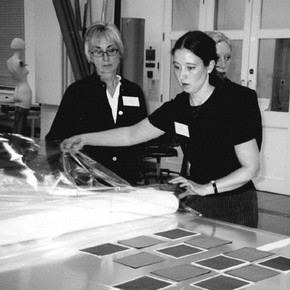Conservation Journal
Summer 2002 Issue 41
A review of adhesives today – Exploring current options and application techniques
The Adhesives Today workshop, 22-26 April 2002, was jointly organised by the Victoria and Albert Museum, the Canadian Conservation Institute and the British Museum.
Who came?
20 Textile conservators came from the United Kingdom, Italy, United States, Brazil, Canada, Germany, Netherlands, Switzerland and Singapore.
What did the participants get?
Free flow of coffee started each day, in preparation for the incredible amount of information and knowledge to be gained at every session. Lectures covered adhesives from the past to the present, their applications and techniques. Current adhesive research and findings were also reported, including customised adhesive formulation and a study of adhesive treatments. Issues of reversibility were discussed and case histories were shared through key speakers’ lectures and participants’ talks, creating a wealth of information and expertise exchange. Some textiles that had been treated with adhesive were brought in for close examination. A walk around the museum highlighted displays that had been treated with adhesive. These treatments largely involved the use of Beva 371, Mowilith DMC2, Lascaux 360/498 and Klucel G.
What did the participants do?

Figure 1. Using the vacuum hot table for application of adhesive. Photography by Jacinta Loh (click image for larger version)
The workshop was very well organised. Participants used the adhesives and techniques that were discussed during the earlier parts of the day. It was real-time experience, with the specialists a smile away. Participants were shown the role of microscopy in adhesive treatments and the preparation of substrates and support fabrics. They tried several application techniques, with a session on the application of adhesive support to the textile using spatula, vacuum hot table and solvent reactivation. Cold lining techniques, microwave pastes and paper repair technique were also demonstrated. On top of that, participants tried adhesive removal techniques. These covered vapours, gels, poultices, mechanical, heat, swabs and immersion approaches. And at the end of each day, participants and organizers shared the day’s experience in a wrap-up session.
What did everyone take away?
Some people came with adhesives experience while others had comparatively less, but this did not create an obstacle. Instead, it was key to the workshop as it created the chance to share and exchange. It did not matter if one was a lecturer or an intern, everyone was a student once more. Though everyone has gone their separate ways, they have been bonded by the adhesives workshop. Not only have they gained new knowledge, they have also been empowered with the zeal to consider and to use adhesives in their work. And they have formed a new bond of friendship, too. Each has walked away with much, but I must highlight two other important mementoes that were given to everyone – the file of notes and the file of adhesive samples. They are not merely files; they are a fractional reflection of a team of dedicated people caring for the development of their peers.
Acknowledgements
I would like to thank Lynda Hillyer, Head of Textiles Conservation for this invaluable opportunity to do an internship at the V&A and to participate in this workshop. Many thanks too to Zenzie Tinker for a wonderful and fruitful learning experience.
Summer 2002 Issue 41
- Editorial
- Tiaras - Mount making and installation
- Sharing museum skills
- Training matters: My experience in the painting conservation section
- Developing a collaborative approach to the conservation of lacquer
- Preservation of the Satyajit Ray paper archive: Fieldwork - January 2002
- A Japanese scroll painting conservation course
- A review of adhesives today – Exploring current options and application techniques
- The observed object: the distance between the studio and the gallery
- The importance of being less earnest: Communicating conservation
- Printer friendly version